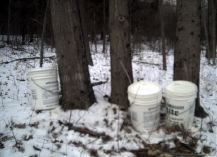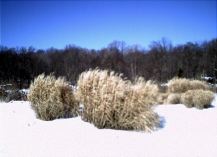The City of Bloomington Streets Department has delivered all the leaves
it vacuumed from the streets this fall, thus creating the largest leafpile
in the county! We'll let the leaves decompose for a while, and eventually
mix them with grass, and form them into beds, where we'll grow flowers,
veggies, and herbs.
The City finally delivered its last load of Christmas trees and fall yardwaste to us - on February 7th!


When the nights freeze but the afternoon sunshine thaws the trees, the
sap starts to flow. We placed 67 taps in 60 trees. Their highest
flow day was February 21, when they gave us 80 gallons. The warm
weather since then has suppressed flow almost entirely. Today, I
collected only 8 gallons (3 of which came from 3 trees)! So far,
we've produced about 4 gallons of syrup, total. That might be it
for the season.
Willson built our sap boiler, which holds two 40 gallon trays. The boiling trays fit the boiler exactly, and seal on it, so that no heat escapes through cracks. The front opens, and is wide enough to accept an old pallet.
Each tray is about 8" deep. When sap flow maximizes, we'll fill them
to about 2" deep, and keep adding sap as the water evaporates off. We've
found that it takes at least 40 gallons of sap to make one gallon of syrup.
The sugar content seems to be highest early in the season, which is why
we tried to get an early start on syrup production. I've taken notes
on each tree, regarding it's relative light exposure, distance to other
trees, size, sap flow volume, and specific gravity (to determine sugar
content). It would be helpful to be able to identify the "sweetest"
and "runniest" trees before tapping next year. On the next rainy
day, I'll post my notes here.

